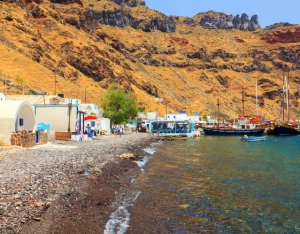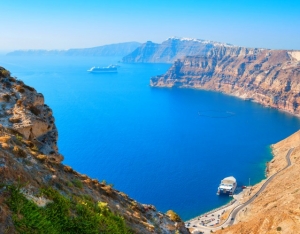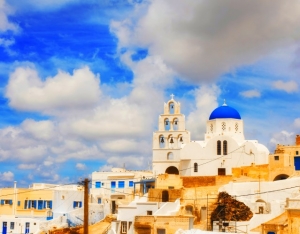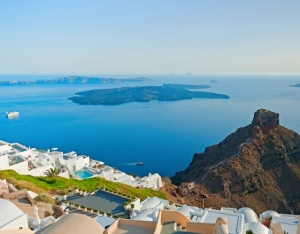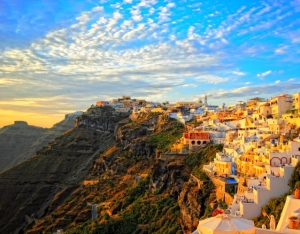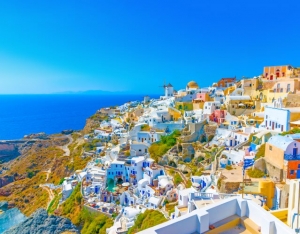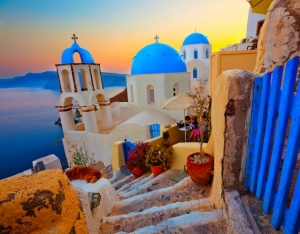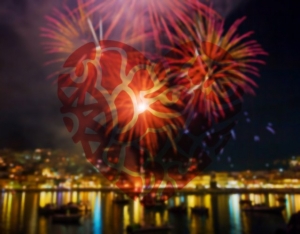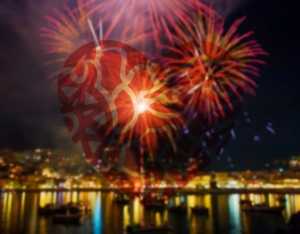Thodoris Bgenopoulos
Thirasia is a tiny island west of Santorini. Until its abruption due to the Minoan eruption of the volcano in 1600 BC, it was a part of island Strogyli.
Thirasia is 9,246 square km and has over 300 permanent residents, while for many it is a miniature of Santorini. The myth has it that it took its name from the younger daughter of the king of Thira, to whom the isle was granted. The island's capital is Manolas.
Thirasia has two main beaches, Riva and Korfos. Riva, which is also the main harbor of Thirasia, has sand and clear waters. This is the docking place for the small boats coming from Ammoudi. Korfos beach is right under the rocks of the caldera, has small pebbles and deep waters. You can reach it from sea with a kaiki or on foot, if you are into a 200 steps downhill. Of course the island has several other small beaches, with not so easy access, that invite the visitor to discover and enjoy them.
Thirasia is an ideal destination for those who love hiking, as they can wander in the picturesque alleys of Manola and the entire island, in a beautifully serene environment.
From Santorini you can visit Thirasia with small boats either from Ammoudi in Oia or with boat from the port of Athinios, and you will be surely satisfied with your choice.
Southwest of Fira is Athinios, the new bigger harbor of Santorini. Here large ships and cruise ships moor, while Athinios is also the starting point for boats that go to Thirasia and the volcano.
The village of Pyrgos is 7.5 km from Fira, at the foot of Mesa Mountain. Right after the abandonment of the Castle of Skaros, Pyrgos became the capital of Santorini and remained until Fira took its place. Pyrgos was one of the five castles of Santorini, a castle that you have to explore thoroughly.
In the wider region of Pyrgos you will stumble upon more than 40 small and big churches, each with its own characteristic, while you should not miss the ecclesiastic collection in Agia Triada and the folk museum "Vanishing Santorini".
Only 3 km from Fira and situated in the highest point of the caldera (300 m from the sea), there is the picturesque Imerovigli, hosting the best view of the volcano. Its name indicates that in the past here was probably a vigla (observatory) to identify the pirate ships.
Imerovigli has been declared a traditional community and therefore the authorities have imposed restrictive building codes. Of course this does not mean that it lacks luxury hotels, restaurants, shops and anything a visitor may wish for, making wandering the narrow streets even more beautiful.
In front of Imerovigli is the now abandoned Castel of Skaros. Built in 1207, it was the capital of Santorini until the 18th century, when it was abandoned after suffering terrible disasters due to the volcano. Today only a few ruins are preserved.
The settlement of Fira, built on the caldera, is the capital of Santorini island. It was founded in the late 18th century, when the Skaros castle in Imerovigli was abandoned.
Just below Fira lies Gialos, the old harbor of Santorini. If you want to go from the port to Fira, you have multiple options, ranging from a modern teleferic, to traditional donkeys or a nice walk.
Fira is the center of all activity in Santorini. Here you will literally find everything. Luxury hotels, inns, shops for all tastes, jewelers, galleries, restaurants, bars.. Whatever you wish for, you will find it in Fira.
Besides the unique view that accompanies you in each step you take, there are many worth seeing museums, among which is the Museum of Prehistoric Thira in Thira and the Archaeological Museum of Santorini.
Oia is a village in Santorini, known around the world for its wondrous sunset.
It is located in the northern part of the island, in a height of 121 m and a distance of 11 km from Fira.
Throughout the day, visitors can wander in the picturesque alleys of Oia, which is listed as a protected traditional community, and admire the unique cave buildings that are typical of Santorini. Moreover, the Maritime Museum of Oia is also worth a visit. In Oia there are many hotels, restaurants and shops that satisfy even the most demanding visitor.
And once the skies are painted in purple and orange, the sunset time approaches... As you will see Oia, just like Fira and Imerovigli, is bound to become jam-packed. Lots of people come to enjoy this enchanting sunset overlooking Thirasia and the volcano, a truly unforgettable experience.
The perfect conclusion to such a day is a relaxing drink in the lovely bars of the island.
The history of Santorini is linked to the volcano. Based on the findings of Akrotiri, Santorini was already inhabited by the 3rd millennium BC. Around 1600 BC the Minoan eruption takes place, sinking a central part of the island and creating the caldera (an underwater crater), an area of approximately 83 square kilometers. Because of this explosion, some researchers identify Santorini with the mythical Atlantis. Santorini was colonized by the Spartans, who gave the island the name of their king, Thira. With the rise of the Byzantine Empire, the island gets under the Byzantine control and after 1204 and the Frankish rule, passes to the Venetians. The Venetians are the ones to name the island Santorini, from the church of Agia Irini (Santa Irina).
In 1537, Santorini, like the other islands of the Cyclades, falls prey to the notorious Barbarossa and in a short time passes into the hands of the Ottomans. During the Ottoman rule Santorini enjoys trade privileges and economic growth. After the revolution of 1821 the island joins the newly established Greek state. This triggers a long period of commercial and maritime prosperity. The 20th century and the world wars "brake" the development of the island, while the great earthquake of 1956 seems to give Santorini the final strike. And yet, Santorini rises from its ashes (almost literally) and thanks to the volcano and the caldera becomes a top tourist destination and experiences a new golden age.
Santorini is one of the most famous greek islands, belonging to Cyclades. It is worldwide known for its volcano, the unique caldera and a sunset that takes your breath away. Santorini is a top touristic destination for vacations and that is exactly how the approximately 12.500 residents of the island multiply each summer. Many of the visitors choose to get married in Santorini.
The island stretches out to 76 square km and the length of its seashore is more than 69 km. Fira is the capital of the island and under its administration are the islands Thirasia, Aspronisi, Palaia & Nea Kameni and Anydros.
Santorini belongs to the volcanic arc of Aegean, together with Methana, Milos and Nisiros, and is considered to be an active volcano. It is situated in the southern part of the Aegean Sea, while in the north there is Ios island and in the east Anafi. The island looks almost like a horseshoe, a shape due to the various volcanic eruptions. The most important of them is known as the Minoan eruption (about 1600 BC) and altered its original round shape. The soil is volcanic and therefore particularly fertile and favorable to farming. The people of the island mainly cultivate vineyards, from which the famous Santorini wine is produced, fava beans and other agricultural products.
The island is arid and dry, rocky on the volcano's side and smooth in the rest of it. The highest peak of the island is Prophet Elias, with 567 m height. Its climate is temperate desert and, although it is the most southern island of the Cyclades, it is the coldest. In the past inhabitants were intensively engaged in agriculture, animal husbandry and fisheries, whereas today most have turned to tourism.
The Spetses Marathon is a very special race, held every October in the, already free from cars, streets of Spetses. This is why participants compete in an ideal environment for running, having as background one of the most beautiful destinations in Greece. The organization began in 2011 and was immediately embraced by a massive number of people in Greece and abroad. Within a highly athletic weekend, two main events take place: the island's round in a 25 km distance and a 5 km race in the city. Moreover, a swimming race is organized in the sea and a kid's race.
Initially, the whole event was the initiative of "Poseidonion Grand Hotel" and it was immediately embraced by the entire island and visitors. Now it is organized under the auspices of the Municipality of Spetses. So this how Spetses Marathon evolved..from a great idea to a favorite habit.
More information on Spetses Marathon can be found in www.spetsesmarathon.com or the Municipality of Spetses tel. 22980 –20010.
The first weekend after September the 8th is the most famous in Spetses, since then the biggest celebration of the island takes place: Armata.
The Armata is a week full of cultural, religious and other events, which culminates during the weekend, with the representation of the burning of the Turkish fleet in 1822. Back then, while the Greek fleet besieged Nafplio, participating in the revolution against the Turks, a part of the Turkish fleet turned against the defenseless island of Spetses for distraction.
Their aim was to conquer the almost defenseless island and force the Greek ships to rush to Spetses, thereby abandoning the siege of Nafplio.
The only few people of Spetses, who had remained to defend the island, resisted heroically and, led by Kosmas Barbatsis, managed to set fire to the Turkish flagship. So, the rest of the Turks had no other choice, but to eventually abandon the island.
During Armata, when the night falls, this heroic effort is represented with the burning of an effigy of the Turkish flagship and plenty of with fireworks.
Back then, the people of Spetses attributed this unexpected victory also to the help of Holy Mary and thus built the church Panagia Armata to honor her.
As it is considered to be the most important event for Spetses, the whole island is actively involved in the events of Armata. There is a variety of celebrations, performances, exhibitions etc. that will satisfy even the most demanding visitor. Armata is a must-lived experience , just make sure you have made your reservations early because those days the island is heaving with people.

